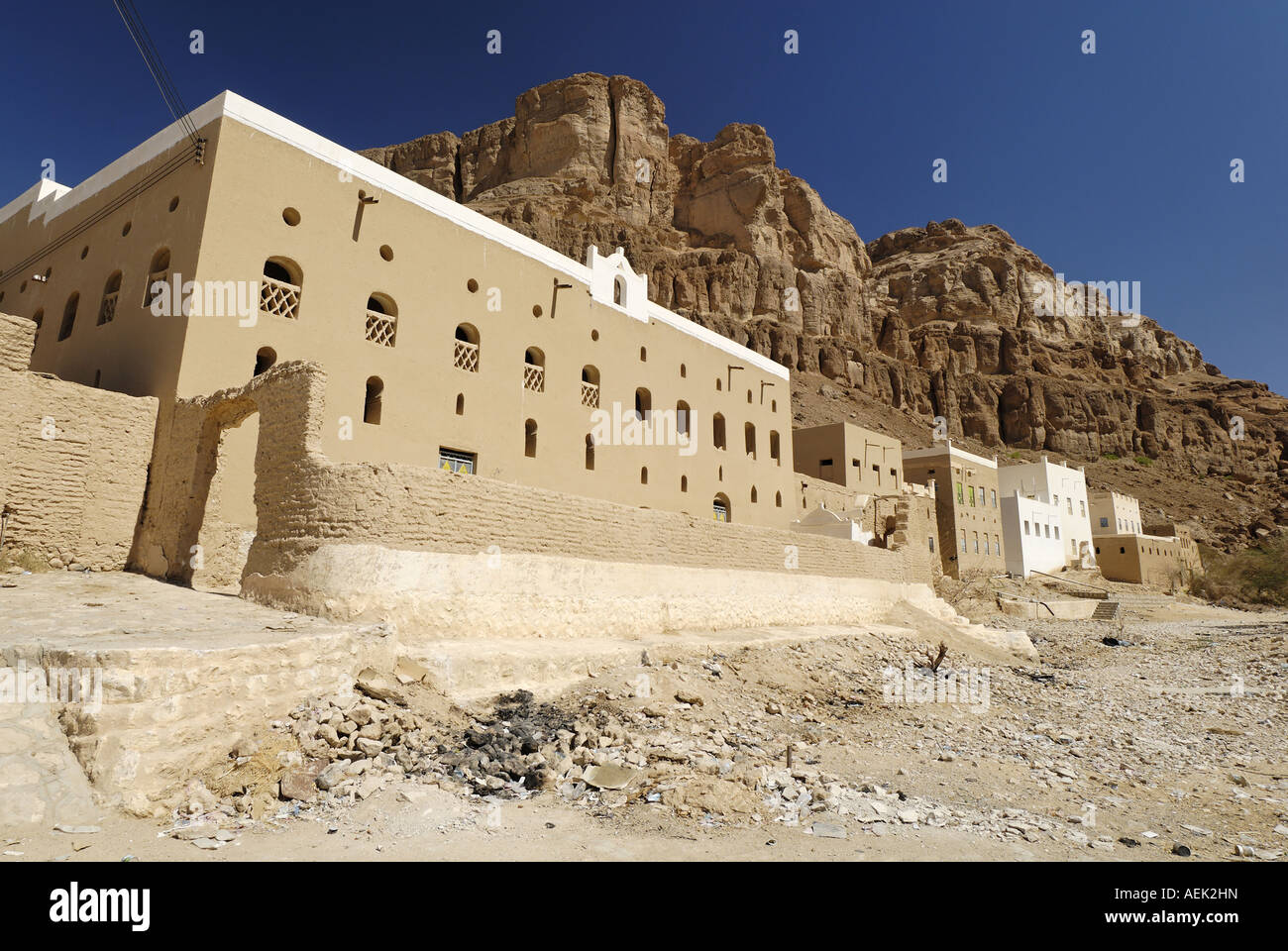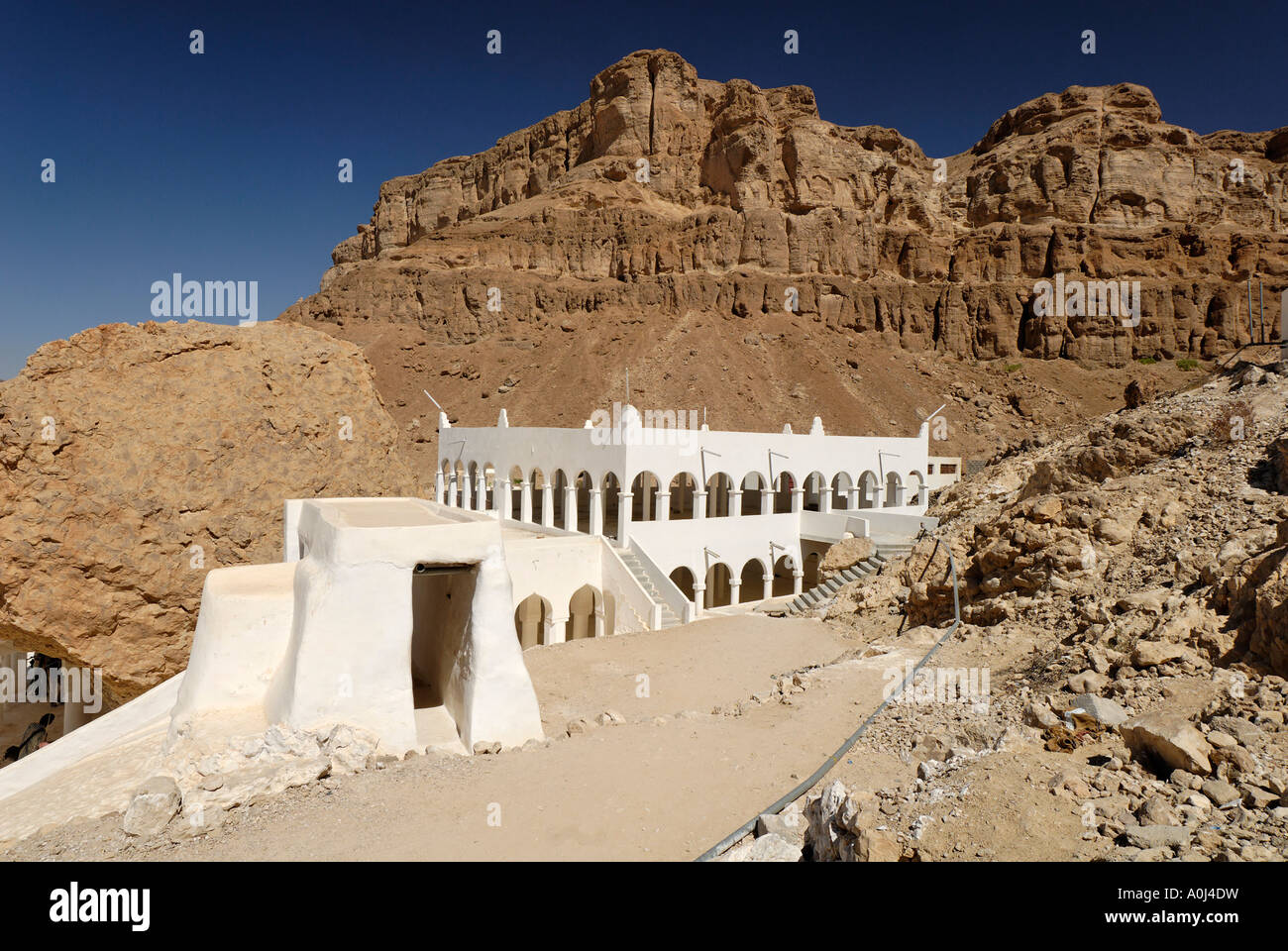

Hud (prophet)
From Wikipedia, the free
encyclopedia
This article is
about the Islamic prophet. For other uses, see HUD.
|
Hud
هود |
|
|
Resting
place
|
Qabr Nabi Hud Hadhramaut
(Possible)[1]
|
|
Other names
|
|
|
Title
|
Prophet
|
|
Predecessor
|
|
|
Successor
|
Saleh or Salih
|
|
Listed by Islamic name and
Biblical name.
|
|
Views[show]
|
|
Part of a series on
|
Hud (/huːd/; Arabic:
هود) was a prophet
of ancient
Arabia mentioned in the Qur’an.[2][3][4][5][6][7][8]
The eleventh chapter
of the Quran, Hud, is named after him, though the narrative of Hud
comprises only a small portion of the chapter.[3]
See also: Arabian
Desert and Rub' al Khali
Hud has sometimes been identified
with Eber,[9]
an ancestor of the Israelites who is mentioned in the Old
Testament.
He is said to have been a subject of
a mulk (Arabic: مُـلـك, kingdom) named after its founder, ‘Ad, a fourth-generation
descendant of Noah
(his father being Uz, the son of Aram,
who was the son of Shem,
who, in turn, was a son of Noah):
The ʿĀd people,
with their prophet Hud, are mentioned in many places. See especially Quran 26:123–140 (Yusuf Ali), and Quran 46:21–26 (Yusuf Ali). Their story belongs to Arabian
tradition. Their eponymous ancestor ‘Ad was fourth in generation from Noah,
having been a son of 'Aus, the son of Aram, the son of Sam, the son of Noah.
They occupied a large tract of country in Southern
Arabia, extending from Umman at the mouth of the Persian
Gulf to Hadhramaut and Yemen at the
southern end of the Red Sea. The people were tall in stature and were great
builders. Probably the long, winding tracts of sands (ahqaf) in their
dominions (46:21) were irrigated with canals. They forsook the true God, and
oppressed their people. A three years famine visited them, but yet they took no
warning. At length a terrible blast of wind destroyed them and their land, but
a remnant, known as the second ʿĀd or the Thamud (see below)
were saved, and afterwards suffered a similar fate for their sins. The tomb of
the Prophet Hud (qabr Nabi Hud) is still traditionally shown in Hadhramaut,
latitude 16 N, and longitude 491⁄2 E, about 90 miles
north of Mukalla.
There are ruins and inscriptions in the neighborhood.
The other tribes claimed to be
present at this time in Arabia, were the Thamud, Jurhum, Tasam,
Jadis, Amim, Midian,
Amalek Imlaq,
Jasim, Qahtan,
Banu Yaqtan and others.[11]
The Quran gives the location of ʿĀd
as being Al-Aḥqāf (Arabic:
الأَحـقَـاف, "The
Sandy Plains," or "the Wind-curved Sand-hills").[6][12][13]
It is believed to have been in the southern part of the Arabian
Peninsula, possibly in eastern Yemen and/or western Oman. In November
1991, a settlement was discovered and hypothesized for Ubar,[14]
which is thought to be mentioned in the Qur'an as Iram dhāṫ al-‘Imād (Arabic:
إِرَم ذَات
الـعِـمَـاد, Iram of the Pillars; an alternative
translation is Iram of the tentpoles),[8][13]
and may have been the capital of ʿĀd. One of the members of the original
expedition, archeologist Juris Zarins, however, later concluded that the discovery
did not represent a city called Ubar.[15][16]
In a 1996 interview on the subject he said:
If you look at the classical texts
and the Arab historical sources, Ubar refers to a region and a group of people,
not to a specific town. People always overlook that. It's very clear on
Ptolemy's second century map of the area. It says in big letters "Iobaritae".
And in his text that accompanied the maps, he's very clear about that. It was
only the late medieval version of One Thousand and One Nights, in the
fourteenth or fifteenth century, that romanticised Ubar and turned it into a
city, rather than a region or a people."[17]
Narrative
in the Quran
This is a brief summary of Hud's
narrative, with emphasis on two particular verses:
The people of ʿĀd were extremely
powerful and wealthy and they built countless buildings[18]
and monuments to show their power. However, the ʿĀd people's wealth ultimately
proved to be their failure, as they became arrogant and forsook God and began to adopt idols
for worship, including three idols named Samd, Samud and Hara.[11]
Hud, even in childhood, remained consistent in prayer to God. It is related
through exegesis
that Hud's mother, a pious woman who had seen great visions at her son's birth,
was the only person who encouraged Hud in his worship. Thus, the Lord
raised up Hud as a prophet for the ʿĀd people.
When Hud started preaching and
invited them to the worship of only the true God and when he told them to repent for their
past sins and ask for mercy and forgiveness, the ʿĀd people began to revile him
and wickedly began to mock God's message. Hud's story epitomizes the prophetic
cycle common to the early prophets mentioned in the Quran: the prophet is sent
to his people to tell them to worship God only and tells them to acknowledge
that it is God who is the provider of their blessings[9]
The Quran[3]
states:
We sent to the people of 'Ad their
brother Hud, who said: "O my people, worship God; you have no other god
but He. (As for the idols,) you are only inventing lies.
O my people, I ask no recompense of you for it: My reward is with Him who created me. Will you not, therefore, understand?
O my people, beg your Lord to forgive you, and turn to Him in repentance. He will send down rain in torrents for you from the skies, and give you added strength. So do not turn away from Him as sinners."
They said: "O Hud, you have come to us with no proofs. We shall not abandon our gods because you say so, nor believe in you.
All we can say is that some of our gods have smitten you with evil." He replied:" I call God to witness, and you be witness too, that I am clear of what you associate (in your affairs)
Apart from Him. Contrive against me as much as you like, and give me no respite.
I place my trust in God who is my Lord and your Lord. There is no creature that moves on the earth who is not held by the forelock firmly by Him. Verily the way of my Lord is straight.
If you turn away, then (remember) I have delivered to you the message I was sent with. My Lord will put other people in your place, and you will not be able to prevail against Him. Indeed my Lord keeps a watch over all things."
O my people, I ask no recompense of you for it: My reward is with Him who created me. Will you not, therefore, understand?
O my people, beg your Lord to forgive you, and turn to Him in repentance. He will send down rain in torrents for you from the skies, and give you added strength. So do not turn away from Him as sinners."
They said: "O Hud, you have come to us with no proofs. We shall not abandon our gods because you say so, nor believe in you.
All we can say is that some of our gods have smitten you with evil." He replied:" I call God to witness, and you be witness too, that I am clear of what you associate (in your affairs)
Apart from Him. Contrive against me as much as you like, and give me no respite.
I place my trust in God who is my Lord and your Lord. There is no creature that moves on the earth who is not held by the forelock firmly by Him. Verily the way of my Lord is straight.
If you turn away, then (remember) I have delivered to you the message I was sent with. My Lord will put other people in your place, and you will not be able to prevail against Him. Indeed my Lord keeps a watch over all things."
— Qur'an, sura 11 (Hud), ayah 50-57
Hud preached to the people of ʿĀd
for a long time. The majority of them, however, refused to pay any notice to
his teachings and they kept ignoring and mocking all he said. As their
aggression, arrogance and idolatry deepened, God, after plenty of warning, sent
a thunderous storm to finish the wicked people of ʿĀd once and for all. The
destruction of the ʿĀd is described in the Quran:[6]
So when they saw it as a cloud
advancing towards their valleys, they said: "This is just a passing cloud
that will bring us rain." "No. It is what you were trying to hasten:
The wind which carries the grievous punishment!
It will destroy everything at the bidding of its Lord." So in the morning there was nothing but their empty dwellings to be seen. That is how We requite the sinners.
It will destroy everything at the bidding of its Lord." So in the morning there was nothing but their empty dwellings to be seen. That is how We requite the sinners.
— Qur'an, Surah 46 (Al-Ahqaf),
ayah 24-25
In
other religions
Judaism and Christianity
do not venerate Hud as a prophet and, as a figure, he is absent from the Bible. However,
there are several pre-Quranic references to individuals named Hud or possessing
a name which is connected to Hud as well as references to the people of
ʿĀd.[9]
The name Hud also appears in various ancient inscriptions,
most commonly in the Hadhramaut region.
Place
of burial
Several sites are revered as the
tomb of Hud. The most noted site, Kabr Nabi Hud, is located in the
deserted village of the Hadhramaut region, around 90 mi (140 km) north
of Mukalla,
and is a place of frequent Muslim pilgrimage.
Robert Bertram Serjeant in his study of the
pilgrimage rite to the tomb of Hud verified on the spot[19]
the facts related by al-Harawi,[20]:97/220-1
who described, at the gate of the Mosque, on the west side, the rock onto which Hud climbed to
make the call to
prayer and mentioned the grotto of Balhut at the bottom of the
ravine.[1]
Around the tomb and neighborhood, various ancient ruins and inscriptions have
been found.[21]
However, as is often the case with the graves of prophets, other locations have
been listed. A possible location for his qabr (Arabic:
قـبـر, grave) is
said to be near the Zamzam Well,[20]:86/98
or in the south wall of the Masjid
in Damascus.[20]:15/38
Some scholars have added that the Masjid has an inscription stating:
"Hadha Maqam Hud" (Arabic:
هـذا مـقـام
هـود, "This
is (the) Tomb of Hud");[22]
others, however, suggest that this belief is a local tradition spewing from the
reverence the locals have for Hud.[1]
Please share as you read okay you may save a soul today,natural herbs
ReplyDeleteare really great, I was cured from HIV positive by a doctor
called DR ONUWA from West Africa, now I believe that natural
herbs and roots has their own way of working, based on medical report
I was told that HIV positive has no cure even when I saw a post
about Dr ONUWA how he cured many people with his herbal medicine I
doubted it at first but just decided to give it a try because I was so desperately trying to get rid of my problems not knowing it was going to be the end of this deadly virus in my body, please if you have anyone with this same virus or diseases like this contact Dr ONUWA on EMAIL DRONUWA2@GMAIL.COM I'm a living testimony of his
herbal medicine and don't forget to share as you read okay,
please save a soul today